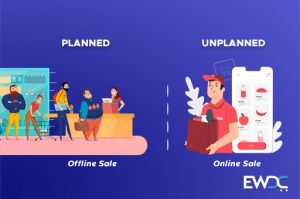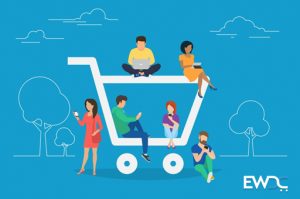
Though the spread of coronavirus (COVID-19) cases in India has had some impact on the ride-hailing firms including Ola and Uber are witnessing a 40-50 percent drop in rides. However, on the flip side, the spread of coronavirus pandemic has come as a boon for e-commerce firms as more people prefer buying goods, especially grocery items, vegetables, and other daily needs from online platforms.
According to the industry insiders, due to the Coronavirus basic protective measures, e-commerce companies such as Amazon, Flipkart, Bigbasket, and Grofers have witnessed about a 20-30% spike in orders as customers are avoiding visiting crowded places like supermarkets and local grocery stores.
Furthermore, there is also an increasing number of people working from home. In such an environment, these firms are doubling down to bring convenience to customers and win their trust. If you have noticed, “in the last two weeks alone, there have been at least a 25 percent spike in orders. This has put extra pressure on the delivery network,” said an e-commerce industry executive.
On the other side, there is a huge fall in high street sales because of increased online competition. Moreover, some retailers were struggling before the coronavirus pandemic began. Perhaps unsurprisingly, its impact has lessened their chances of survival.
However, Brick and mortar Stores selling basic goods that have been allowed to remain open during the lockdown are also experiencing losses as they aren’t allowed to sell other general merchandise and can’t open for a longer time, which would otherwise bring them higher margins.
Overall, there has been a significant impact on apparel, jewelry, shoes, and CDIT (consumer electronics, durables, IT and telephones) retail,” says Kumar Rajagopalan, CEO, Retailers Association of India.
Furthermore, Rajagopalan fears that if the lockdown period continues till June 2020, India is staring at a scenario where 30 percent of the retail stores would shut down, leading to 18 lakh people losing their jobs.
So, by reading this article, you come to understand the future of consumer Shopping behavior after the pandemic Coronavirus Outbreak. And what you can do?
First, Understand the Difference Between Retail and E-commerce
In the simplest terms, both retail and e-commerce seem to be very similar: they generally refer to the selling of any products from a business to an individual consumer for their personal use, except one of them is done exclusively through the Internet.
Retail can be carried out in a number of ways: in a brick and mortar establishment like a grocery store, shopping mall or, online, person-to-person sales, or even direct mail.
Whereas, E-commerce, on the other hand, refers to commercial transactions. This is primarily made electronically through the Internet. There is something known as “retail e-commerce sales,” which refers to the sale of goods and services. Here, the business and transaction take place on the Internet either through an extranet, Electronic Data Interchange (EDI), or similar online systems.

Currently, many merchants globally fall somewhere between brick and mortar retail and e-commerce.
Traditional retail or the shopping experience is something where you go out to a certain company to purchase a good or service that is certainly alive and well. This most basic form of shopping is carried out and will likely always exist.
However, there are many stores that exist both as a brick and mortar storefront as well as an online shop. Take for example stores like Target, Walmart, or Forever 21. Each of these establishments can be visited and shopped through their online websites or you can visit their nearest store and walk around the actual place.
However, it doesn’t mean- While online shopping is popular and the numbers have steadily continued to increase over the years, the brick and mortar stores like shopping malls, groceries, and convenience stores are going old-fashioned. On the contrary, both mediums are still thriving.
It simply means that the world’s shopping habits have changed, leading to an ever-changing future as tech continues to evolve.
So, it’s time for you also to adapt to a fast-paced environment and start growing your business than before.
Retail Store VS Ecommerce Stats:
Top retail sales statistics
Top retail consumer statistics:
Reasons Why Many Millennials started to Prefer Ecommerce Shopping than In-store Today?
Aside from the ability to compare product specifications and browse reviews, online shopping offers a list of other numbers of benefits:
To take things a step further, shoppers can even track shipments, find estimated delivery dates, and even process returns all online as well.
In addition to this, Ecommerce shopping provides promotions, discounts, coupons, and Groupon. All this makes consumers more likely to shop online than go to physical stores.

Moreover, online retailers grab consumer attention from everywhere: through the Facebook page, Google searches, Instagram feed, and more, alerting shoppers to great online deals and discounts only available on the web.
What’s more? Recommendations, advice, and reviews from friends, family, and followers are also easy ways to get deals online, making this one of the easiest modes of shopping.
Thus, E-commerce helps businesses keep an eye on consumers’ buying habits. It has allowed companies to understand their customers’ needs and wants through customer intelligence analytics which gives unique insights that in-store salespeople are not able to gather.
Hence, these benefits have a great impact on businesses and sometimes are seen as the better route to last in a fast-paced developing world.
Bottom Line:
The coronavirus pandemic is pushing more people online.
However, Online grocery shopping was already on the rise, but now it has newfound importance to consumers, giving services the chance to become a key service for customers during and after the pandemic,” analyst Daniel Keyes wrote in the report.
It is very clear that many of the shoppers are switching to online grocery delivery or pickup services to avoid shopping in stores.
Hence, in the evolving age, it is important for your business to always have an online presence, even if it consists of a Facebook page or simple website containing your address and contact information, as well as a brief description of your product or service offerings.
If you do decide you want to sell your products online and skyrocket your local business? Don’t get trouble.
Our online Grocery eCommerce software is loaded with smart features and intuitive eCommerce scripts on a super-customizable platform to make sure your customers and your online store get benefited equally.

Tailored user experience offers your online shop to get more repeated customers by selling groceries online without any hassle.
So, what are you waiting for? Experts said that there would be a permanent shift after the Coronavirus pandemic has passed with more people choosing to shop for groceries online as they become more accustomed to this.
Start switching from offline to online today!